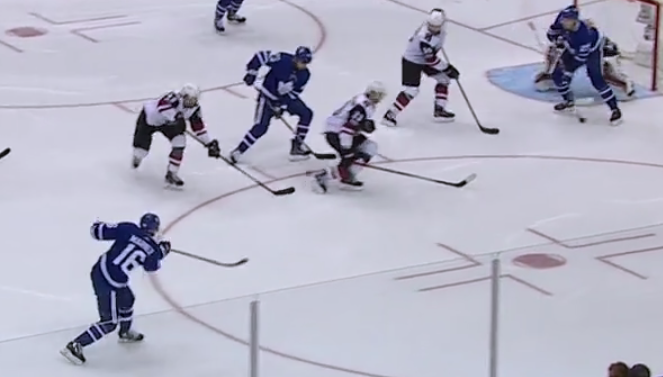Despite a valiant late push, Toronto Maple Leafs had their six-game winning streak snapped by the last-placed — but recently-surging — Arizona Coyotes on Monday night.
Your game in ten:
1. After the game, Mike Babcock seemed to attribute the poor start – Arizona outshot Toronto 10-1 to open the game – to his team under-estimating the opponent, but whatever the reason, it is more of a trend than an anomaly of late. The Leafs were outshot 7-0 to start against Montreal, 6-2 in the first 10 minutes against New Jersey, and 8-1 in the first 10 minutes of the second game against Boston. That’s four consecutive starts where they eased their way into the game and leaned on Frederik Andersen or Curtis McElhinney early. Babcock has switched up the starting fives and it hasn’t helped. Perhaps it was some complacency setting in as the winning streak grew, but it’s a team-wide mentality/preparation issue that needs to be fixed.
The Leafs were due for a wake-up call. The habit of finding ways to win without starting on time isn’t a good (or sustainable) one.
2. This game was decided on special teams, with the three goals that weren’t empty netters all coming on the power play. With the two goals against on the penalty kill – it easily could have been three, as they were caught high on one of their successful kills and needed a ten-bell Andersen glove save to bail them out – the Leafs are now ranked 17th on the PK with a 80% success rate. In the month of November, they’re killing at 77%.
You had to tip your cap to some pretty impressive puck movement by the Coyotes on the first goal, but Nikita Zaitsev sent a blind backhand pass up the middle of the ice to start the Arizona possession, Dominic Moore blew a clearance, Ron Hainsey didn’t take advantage of a brief opportunity to clear, and the cross-crease pass to Brendan Perlini for the goal can’t get through all of Zaitsev, Hainsey and Moore.
With Zach Hyman right in his grill, Oliver Ekman-Larsson made a good play/shot on the second Arizona power play goal after a lost draw taken by Hyman. The two-winger units aren’t ideal for faceoffs; Leo Komarov is a capable faceoff man who can win his fair share (he’s won 22 of 42 on the PK), but Hyman has won just 13 of 32 shorthanded draws (taken mostly on his strong – right – side), Brown is three for eight, and Marleau is three for eight. The Leafs have won 66 of 136 shorthanded draws overall (48.5%), but it’s been worse lately, with just 27 wins on 62 draws (43.5%) since Nov. 1.
3. The Leafs started that first penalty kill well with multiple rink-length clearances by Hainsey and some good forechecking by Hyman and Komarov that led to a back pass into their own end to kill some time. But, as we’ve seen throughout the first 22 games, Hainsey and Zaitsev stayed out there in lieu of fresh legs. Both are good PKers, but it has to affect the defending/decision-making when they’re breathing heavy late in the PP, which is when the first goal occurred. Babcock has mentioned that he likes the team’s structure on the penalty kill despite its declining results while also acknowledging there might have to be more personnel rotation at some point if the numbers don’t improve. We might be getting to that point soon.
4. As Anthony pointed out in Monday’s notebook, opposing teams are very much aware and accounting for the Leafs’ preferred slot-tip play on the power play, but stopping it is another matter, especially when Mitch Marner is threading the needle like he did on the JVR goal. Marner fit that slap pass through a really small window to find Kadri’s stick blade:

JVR is now up to 11 goals in 21 games, a 42-goal pace. His shots pace hasn’t increased substantially over his 29-goal 2016-17 season — he’s on pace for 243 vs. last season’s 238 — and he’s shooting over 17%. But if he shoots even just his career norm (11.2%) over the rest of the season, maintains a similar shots pace and stays healthy, he’ll finish with 31 goals. Somebody is getting paid.
5. The Leafs were denied a storybook Auston Matthews late tying marker due to a goal reversal for goaltender interference. I don’t doubt that Antti Raanta would’ve played it differently had Zach Hyman not bumped him into his net — he probably gets out to cut down the angle instead of sitting in the butterfly on his goal line — but the question is, what is a reasonable amount of time to allow a goalie to reset? It seemed as though Raanta sort of gave up on the play because of the initial contact. That turned out to be a good call on his part given he was facing down an Auston Matthews point-blank scoring chance, which has better odds of going in than not — even with the goalie in position. There’s a grey area here, to say the least.
It was good to see Babcock go back to Matthews-Marner when chasing the tying goal, this time with Zach Hyman on the left instead of Matt Martin. With William Nylander fighting it at the moment — it’s not all on him; Matthews definitely isn’t 100% back to form yet — it’s getting hard to deny that it would be fun to see this trio assembled for an entire game.
6. Regardless of the overturned goal, between it and the post he rang just after, this was another example of Matthews’ special, superstar quality of rising to the occasion in big moments: the overtime winner in the Centennial Classic, multiple times in the playoffs — including the Game 6 tying goal in the third — among others. He was fighting the puck a bit throughout the game but went out and found another gear when the game was on the line. This would’ve been a special moment for him personally against his childhood team; it’s a shame it was negated on a rules technicality and then by a post.
7. It’s been noticeable that Matthews has been getting targeted and roughed up more often since the injury. Jordie Benn dumped him hard in the Montreal game as he was circling the net without the puck, Max Domi got him pretty good tonight, and has have been more of the little bumps and whacks than usual. The media sometimes gets frustrated about the cone of silence that surrounds injuries, but we all know it’s for a reason; opponents seize on that information. Obviously, there’s no hiding it when Matthews had to sit out for a number of games. The superstar treatment is nothing new for someone like Matthews, who has been dealing with it his whole hockey-playing life, but it’s even more apparent this season and in the past few games in particular. All of the best have to battle through it.
8. Not sure what got into the Jake Gardiner – Nikita Zaitsev pairing late in the game. With around six minutes left, they turned the puck over twice in the middle of the ice at the defensive blue line before Gardiner got driven wide — his stick never even touched the ice as he got walked around — leading to what easily could have been a put-away goal for Arizona. The two of them then lost the puck battle behind the net pretty easily on the empty-net goal. There has been a few too many of these head-shaking shifts from this pairing this season.
9. Shifts like this one make it clear why Babcock doesn’t trust the Connor Carrick – Andreas Borgman pairing fully, but you have to appreciate Andreas Borgman starting his night off by crunching a rushing forward along the boards on his first shift two games in a row — against Brendan Gallagher vs. Montreal and Christian Fischer tonight.
10. Below is a good example of one of the Leafs’ adjustments since their fortunes turned around: activating the defense more for carries through the neutral zone. Morgan Rielly has done an excellent job of it lately, in particular (and of joining the rush in general, also. He’s looking supremely confident attacking the zone). This was a really nice sequence from Rielly and Hainsey:
I




































